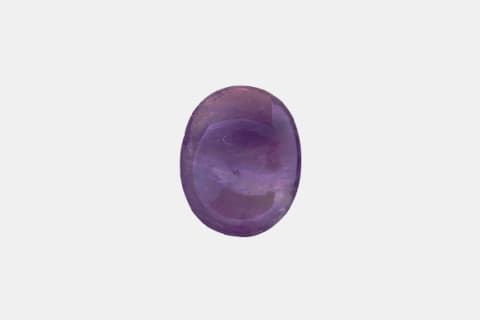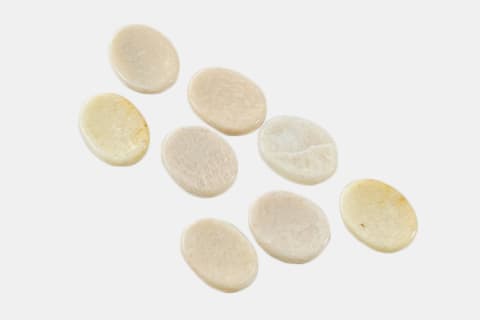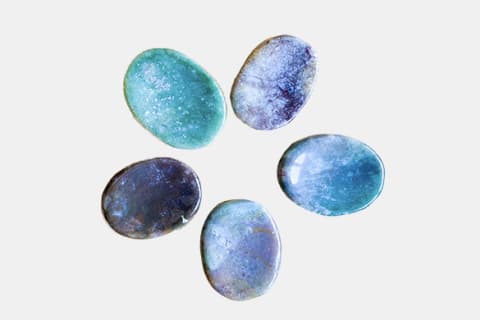Advertisement
The Benefits Of Worry Stones & How To Clutch Them To De-Stress

Worry stones have been around for centuries—and for good reason. These compact rocks couldn't be easier to keep on hand, ready to grab whenever worry should strike. They're wonderful when you're feeling stressed, soothing to the touch, and an excellent addition to your self-care routine. Curious to learn more? Here's everything you need to know about worry stones.
What is a worry stone?
A worry stone is a small, smooth stone (often made from a crystal or gemstone) that is shaped like an oval and has a thumb-shaped indentation. The object of worry stones is to rub the thumbprint back and forth as a way to calm the mind.
The history of worry stones.
Worry stones have been found all over the world, so the exact origin isn't quite clear. But from what we can tell, people everywhere—from Ancient Greece to Tibet to North America—have all found a sense of peace when taking a moment to touch their worry stone and let their worries go.
What are the benefits?
There are a number of benefits to keeping a worry stone on hand, but the main one would have to be stress relief.
"For many people, worry stones are just an actual physical touchpoint when they're dealing with stress and anxiety," founder and educational director of the Love and Light School of Crystal Therapy Ashley Leavy explains to mbg. If you're the kind of person who struggles to meditate or do breathwork, she adds that "having that physical touchstone can be really helpful."
You can also assign your worry stone a specific intention, notes founder of Astara and crystal expert, Mariah K. Lyons. Whenever you see and touch your stone, she says, you "have a visual reminder of a specific intention you set"—be it finding more gratitude in life or challenging negative thought loops.
Again, the whole idea is that the stone can help absorb your worries, Leavy says, given that it is an element from the earth. And thanks to our acupressure points in the thumbs, she adds, worry stones can not only help you calm your worries but also make you feel a little happier in the moment, too.
When to use a worry stone:
When you're feeling stressed.
This encompasses so many scenarios; big interview coming up? Getting ready for a date? Stressing about the state of the world? The sky's the limit with these stones. As Lyons notes, they're simply nice to have near you at any moment, so "if you are going through a challenging transit, or periods of anxiety [...] you have access to it."
While meditating.
Another way to work with a worry stone is by incorporating it into your meditation practice. Similar to a mala used in Hinduism, which involves saying a mantra for each bead on the necklace, you can recite an affirmation or mantra every time you rub your stone, Lyons says. Or, for a less-involved approach, you can simply hold it in your palm as you meditate. "It gives the mind something to do and can add to the relaxation benefits," she notes.
Before bed.
Stress and anxiousness have a knack for striking at the worst times—like when you're trying to fall asleep. Let all the worries of the day go by grabbing your worry stone before bed, Lyons suggests. "You could even have one in the bath with you if that feels nice," she adds.
On a walk.
"So often [we] think of meditation as being passive," Leavy says, "but it can be a walk in nature—more of an active thing." Indeed, meditation doesn't come easy for all, but by turning an afternoon stroll into a moving meditation, with the added benefit of incorporating the worry stone, you'll get all the benefits of fresh air and movement, plus channel some stress while you're at it.
During a difficult conversation.
And lastly, if you struggle to keep your cool during arguments, that's another great opportunity to call on your worry stone. Reach for it when you feel tempers flaring, and give yourself a moment to gently rub the stone a few times and take a deep breath before you decide to speak.
10 types of worry stones:
- Rose quartz
- Jade
- Clear quartz
- Amethyst
- Lapis lazuli
- Moonstone
- Agate
- Smoky quartz
- Granite
- Soapstone
These are 10 common worry stones, but there are plenty of other varieties available today. As Lyons notes, you can make worry stones out of lots of different materials, and most crystals will work, depending on the cut. In tourist hot spots, it's not unlikely to find them made from local rock, Leavy adds. What it really comes down to is your intention for the stone, which can help you decide which type of crystal might be best for you.
Try these stones:
Worry stone alternatives.
Now, if you don't have a worry stone yet but you're into the idea of clutching onto something for comfort, you can totally use your own object of choice for a similar effect. Other earthy options include things like pebbles or rocks, Leavy says, perhaps a seashell or a piece of smooth sea glass, or even a coin that means something to you.
Lyons says you could also use a necklace or bracelet if you like, or to keep it even simpler, a piece of paper with whatever your intention is (i.e., I am at peace in the present moment). Whatever you choose, keep it on hand and use it as a reminder to come back to the moment every time you need it.
The bottom line.
We all deal with worry, so it's important to have a tool belt of sorts to give us a hand when we need it. It may sound too good to be true, but the simple brush of a worry stone can help bring you back to the present moment and carry on with your day a little lighter.


